-
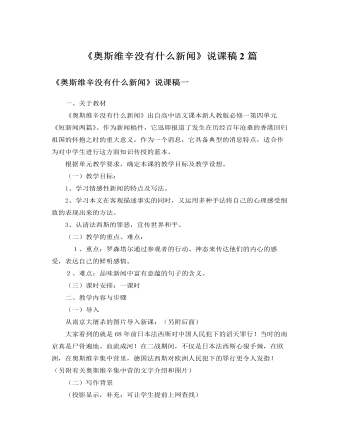
人教版高中语文必修1《奥斯维辛没有什么新闻》说课稿2篇
第11段很短,只点出了这是“在妇女身上搞不育试验的地方”,但在最末又加了一句“否则他会羞红了脸的”,这是为什么?那肯定是一个极为肮脏,极为残酷的地方。据资料记载:当时的希特勒制定一项令所有被征服或占领国家的民族充当奴隶并且逐渐消亡的隐密性种族灭绝计划——高效率、大规模的强制绝育。为此,数以百计的纳粹医生、教授、专家甚至护士,在行政管理专家的通力合作下,相继提出了几十种绝育方法,十余种实施方案,并且在奥斯维辛、拉芬斯布吕克、布亨瓦尔特、达豪等十多个大型集中营内对数以万计的犹太、吉普赛囚犯、因从事抵抗运动而被捕的政治犯和男女战俘进行了残酷的手术试验,造成他们大量死亡或者终身残疾、终身不育。这样残酷的毫无人性的手段,任谁也不愿看到。
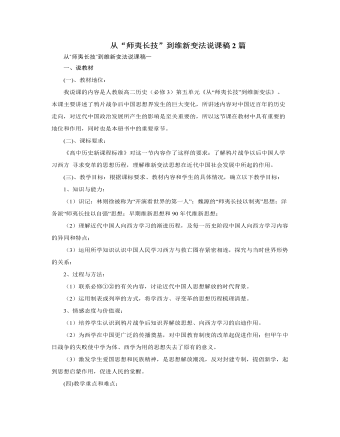
人教版高中历史必修3从“师夷长技”到维新变法说课稿2篇
(一)、教材地位:我说课的内容是人教版高二历史(必修3)第五单元《从“师夷长技”到维新变法》。本课主要讲述了鸦片战争后中国思想界发生的巨大变化,所讲述内容对中国近百年的历史走向,对近代中国政治发展所产生的影响是至关重要的,所以这节课在教材中具有重要的地位和作用,同时也是本册书中的重要章节。(二)、课标要求:《高中历史新课程标准》对这一节内容作了这样的要求:了解鸦片战争以后中国人学习西方 寻求变革的思想历程,理解维新变法思想在近代中国社会发展中所起的作用。(三)、教学目标:根据课标要求、教材内容和学生的具体情况,确立以下教学目标:1、知识与能力:(1)识记:林则徐被称为“开演看世界的第一人”;魏源的“师夷长技以制夷”思想;洋务派“师夷长技以自强”思想;早期维新思想和90年代维新思想;
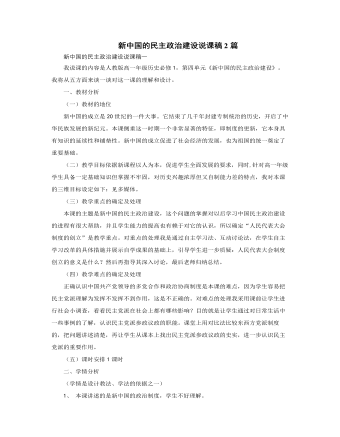
人教版高中历史必修1新中国的民主政治建设说课稿2篇
(一)教材的地位新中国的成立是20世纪的一件大事。它结束了几千年封建专制统治的历史,开启了中华民族发展的新纪元。本课侧重这一时期一个非常显著的特征,即制度的更新,它本身具有知识的延续性和铺垫性。新中国的成立促进了社会经济的发展,也为祖国的统一奠定了重要基础。(二)教学目标依据新课程以人为本,促进学生全面发展的要求,同时,针对高一年级学生具备一定基础知识但掌握不牢固,对历史兴趣浓厚但又自制能力差的特点,我对本课的三维目标设定如下:见多媒体。(三)教学重点的确定及处理本课的主题是新中国的民主政治建设,这个问题的掌握对以后学习中国民主政治建设的进程有很大帮助,并且学生能力的提高也有赖于对它的认识,所以确定“人民代表大会制度的创立”是教学重点。
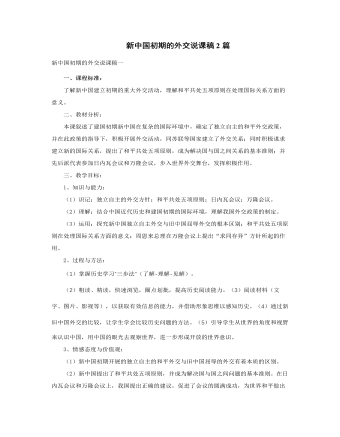
人教版高中历史必修1新中国初期的外交说课稿2篇
四、教学过程1.导入新课(2分钟)出示中非合作论坛暨第3届部长级会议图片。用时事引起学生注意,设问,“55年前,亚洲与非洲有哪一次跨越印度洋的握手”,提示答案“万隆亚非会议”,给出答案导入新课2.外交环境:学生阅读,教师分析。(3分钟)3.外交方针之一:独立自主的和平外交方针(5分钟) 出示材料:《共同纲领》引文。学生、阅读、提炼除新中国奉行独立自主的外交政策。进而由学生分析另起炉灶、打扫干净屋子再请客和一边倒。培养学生分析材料、利用材料的能力过度:新中国作出一边倒大的积极主动态势,社会主义阵营的兄弟们也立刻作出了积极回应。1949年10月2日,中苏建立了外交关系。4.外交建树之一:同苏联等17个国家建立外交关系(3分钟)出示毛泽东访问苏联等图片和第一批建交的17个国家名字
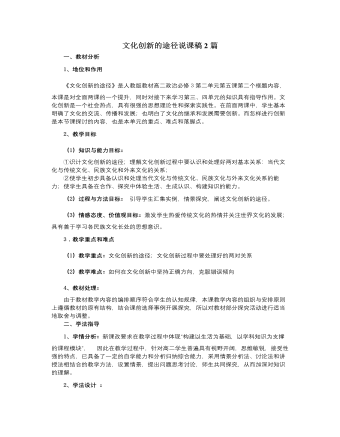
人教版高中政治必修3文化创新的途径说课稿2篇
PPT:文化创新的途径环节二:(展示情境 探究问题)情境一:先后展示徐悲鸿的《奔马图》和《愚公移山》设计意图:在作品的选择上遵循由易到难,由感性到理性的原则让同学们从中体会作者的创作情怀,比较两幅图表达的心境不同之处及其原因。探究一:从创作背景的不同,探究文化创新的根本途径。PPT:(设问)1、为什么同一画家在不同时期,作品所反映的内容不同?2、从中我们可看出,文化创新的根本途径是什么?设计意图:引导学生分析时代的变化对人们的社会实践的影响,因而文化工作者在体验生活的过程中创作的作品意境也会不同,培养学生透过现象看本质的能力,得出文化创新的根本途径是社会实践。教师过渡:在社会实践中,徐悲鸿先生还有什么创作的成功秘诀吗?探究二:从创作心得的展示,探究文化创新的重要途径(PPT)徐悲鸿一生致力于国画的创新实践,他认为革新中国绘画的要旨在于:“古法之佳者,守之;不佳者,改之;垂绝者,继之;未足者,增之;西方画之可采入者,融之。” 设计意图:通过阅读材料,培养学生寻找关键词的能力,并从中总结归纳文化创新的重要途径----继承传统、推陈出新。
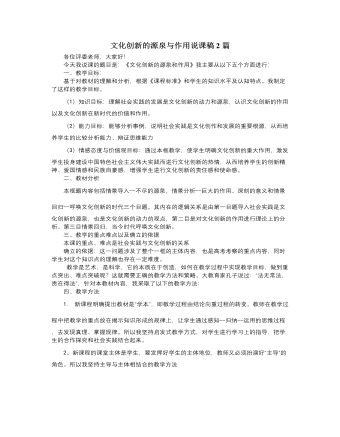
人教版高中政治必修3文化创新的源泉与作用说课稿2篇
一、教学目标:基于对教材的理解和分析,根据《课程标准》和学生的知识水平及认知特点。我制定了这样的教学目标。(1)知识目标:理解社会实践的发展是文化创新的动力和源泉,认识文化创新的作用以及文化创新在新时代的价值和作用。(2)能力目标:能够分析事例,说明社会实践是文化创作和发展的重要根源,从而培养学生的比较分析能力、辩证思维能力(3)情感态度与价值观目标:通过本框教学,使学生明确文化创新的重大作用,激发学生投身建设中国特色社会主义伟大实践而进行文化创新的热情,从而培养学生的创新精神、爱国情感和民族自豪感,增强学生进行文化创新的责任感和使命感。二、教材分析本框题内容包括情景导入--不尽的源泉,情景分析--巨大的作用、深刻的意义和情景回归--呼唤文化创新的时代三个目题。其内在的逻辑关系是由第一目题导入社会实践是文化创新的源泉,也是文化创新的动力的观点,第二目是对文化创新的作用进行理论上的分析。第三目情景回归,当今时代呼唤文化创新。

人教版高中语文必修2《囚绿记》说课稿2篇
“深入探究,把握主旨”这一步则是解决教学的重点难点,这里涉及到课文的深层意蕴,学生理解有难度,教师在通过问题引领学生探讨的基础上,还要适时启发、点拨,因为教学时间有限,让学生漫无边际的讨论,可能难以完成预定的教学任务,会使教学过程不完整。至于本文的写作特点的教学视时间而定,有时间可以让学生说一说,没有时间用小黑板出示一下,让学生了解就行,如果时间不够,甚至可以不讲。第三阶段是“延伸练习,巩固提高”。
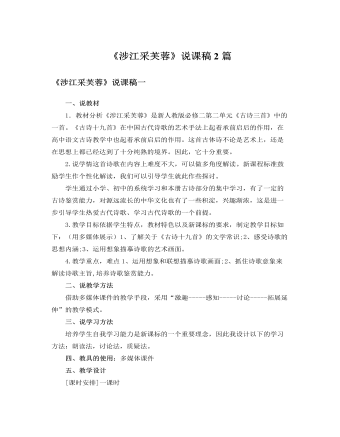
人教版高中语文必修2《涉江采芙蓉》说课稿2篇
一、说教材1.教材分析《涉江采芙蓉》是新人教版必修二第二单元《古诗三首》中的一首。《古诗十九首》在中国古代诗歌的艺术手法上起着承前启后的作用,在高中语文古诗教学中也起着承前启后的作用。这首古体诗不论是艺术上,还是在思想上都已经达到了十分纯熟的境界。因此,它十分重要。2.说学情这首诗歌在内容上难度不大,可以做多角度解读。新课程标准鼓励学生作个性化解读,我们可以引导学生就此作些探讨。学生通过小学、初中的系统学习和本册古诗部分的集中学习,有了一定的古诗鉴赏能力,对源远流长的中华文化也有了一些积淀,兴趣渐浓,这是进一步引导学生热爱古代诗歌、学习古代诗歌的一个前提。3.教学目标依据学生特点,教材特色以及新课标的要求,制定教学目标如下:(用多媒体展示)1、了解关于《古诗十九首》的文学常识;2、感受诗歌的思想内涵;3、运用想象描摹诗歌的艺术画面。
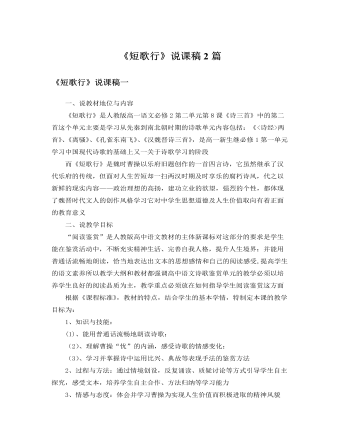
人教版高中语文必修2《短歌行》说课稿2篇
一、说教材《短歌行》是普通高中课程标准实验教科书必修(二)第二单元的一篇略读课文,本单元安排的是先秦到南北朝时期的诗歌。《短歌行》是著名政治家、军事家、文学家曹操的作品。诗中抓住“忧”字来写诗人为什么“忧”,如何解“忧”,从而表达希望能够招揽人才、完成统一天下的雄心壮志。所以本单元安排《短歌行》一诗,对学生全面了解曹操,感受曹操在短暂的人生中竭力创造伟业的气概。二、说学生我这一课的教学对象是高一学生。他们进入高中学习的时间只有三个多月,现在已经完成了必修(一)的学习。学习了现代诗歌单元,有了一定的诗歌学习基础,初步掌握了读诗的基本方法,但是还未能形成成熟的稳定的学习方式。同时,本单元学习是高中第一次接触古代诗歌,诗歌语言上的障碍和时间上的跨度对他们来说都是学习上的困难。因此教师要引导学生自主学习,合作学习,为他们设置新的学习情境,提供合作探究的机会。

人教版高中英语必修2Cultural Relics说课稿2篇
Ⅲ. Analysis of the teaching material:The topic of this unit is cultural relics. Students are quite interested in topics about different cultures around the world. This is the second period of the whole unit. As a reading class, the passage mainly talks about the history of the amber room (how it was made, sent as a gift, lost and rebuilt).According to the new national curriculum, when teaching reading, much emphasis should be put on training the students’ reading skills.Ⅳ. Teaching objectives1. Language objectives:1) Students are required to master the key words and phrases occurred in the passage (e.g. amazing, decorate, belong, in return, less than etc.)2) Students are required to learn the attributive clause and acquire the sentence pattern.2. 1) Students are required to describe a certain thing by using the new sentence patterns.2) Students are required to master two kinds of reading skills—skimming and scanning, and learn to use them in their daily reading.3. 1) Students are required to know the history of the amber room.2) Students are required to appreciate cultural relics and understand the importance of protecting them.Ⅴ. Teaching important and difficult points1) the new words, phrases, and sentence pattern in the course of reading.2) Teaching difficult point: Help the students master two kinds of reading skills—skimmingand scanning and learn to apply them in daily use.Ⅵ. Teaching methods:Task-based method & Top-down model Ⅶ. Teaching aids: PPT, pictures, blackboard Ⅷ. Teaching procedure:

人教版高中英语必修2The Olympic Games说课稿2篇
Purpose of my design:To ask the students to do these two tasks will make the Ss predict the story of this passage. As a result, it will deepen Ss’ memory of this story because they will have their own understanding of this story.Step 3. While-readingTask 1. (Individual work _____min)Skimming: ask students to skim the text and the main ideas of each paragraph in this passage. Please read it quickly and then match the sentences with the letters.Task 2. (Individual work _____min)Scanning: read the text quickly and decide the whether the following statements are true or false and give reasons.Task 3. (Pair work _____min)Listen to the tape and fill in the banks. Then read the paragraph with expression to your partner.Task4 (individual work min)Listen to the tape again and write down the main idea in one sentence.Purpose of my design: Enable students to understand the given material better by using different reading skills. And proper competition can arouse the Ss’ interest in English learning. “Task-based” teaching method is used here todevelop the Ss’ ability of communication and also their ability of co-operation will be well trainedStep 4. Post-readingTask 1. (Individual work, pair work, group work, class work; _____min)Discussion (group of 4):1. If you were Hippomenes, would you run against Atlanta?2. Do you think Hippomenes deserved to win the race? Why or why not?Step 5. HomeworkPlease read the story again carefully after class and imagine: What will happen during the race between Hippomenes and Atlanta? Who do you think will win the race? Do you think Atlanta would marry Hippomenes? Write an end for the story with thses questions.Purpose of my design: Homework is so important and necessary for to master the knowledge they learned after class. It will check whether the Ss achieve the teaching aims.Part 5 Blackboard design
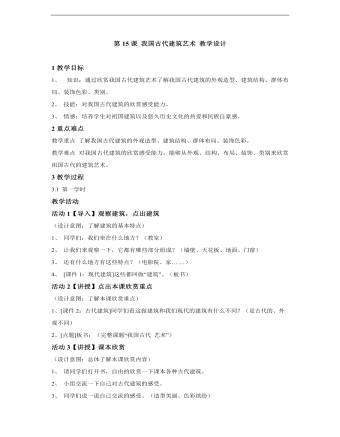
小学美术人教版六年级下册《第15课我国古代建筑艺术》教学设计说课稿
2重点难点教学重点了解我国古代建筑的外观造型、建筑结构、群体布局、装饰色彩。教学难点对我国古代建筑的欣赏感受能力,能够从外观、结构、布局、装饰、类别来欣赏祖国古代的建筑艺术。3教学过程3.1 第一学时教学活动活动1【导入】观察建筑,点出建筑(设计意图:了解建筑的基本特点)1、同学们,我们坐在什么地方?(教室)2、让我们来观察一下,它都有哪些部分组成?(墙壁、天花板、地面、门窗)3、还有什么地方有这些特点?(电影院、家… …)4、 [课件1:现代建筑]这些都叫做“建筑”。(板书)

部编人教版五年级下册《童年的发现》(新版)说课稿
四、说教法和学法:1.说教法:学习这篇课文,要让学生通过自读自悟和讨论交流,了解课文主要内容──“我”发现了什么、是怎么发现的;从中激发学生勤学好问、大胆想象、乐于探究的学习精神;体会心理活动描写对塑造人物形象的重要作用,能真实表达自己的内心感受。2.说学法:在本课的教学中,我主要教给学生学会自主探究,学会自己发现问题和解决问题的方法,学会合作学习,在合作学习中发现和解决更多的问题。引导学生学会抓住重点句段理解课文的方法。五、说教学流程:1.交流揭题,激发兴趣。引导学生回忆交流学过的课文中描写童年生活的片段,由片段交流引出“发现”,由片段交流引出“童年”,由对“童年”的交流引出课题完成“童年的发现”,激发了学生阅读课文的兴趣。2. 紧扣“发现”,初读课文。(1)默读课文,读准字音,读通句子。(2)自学课文生字词,可以用笔在文中圈出来,然后用合适的方法来解决生字词。

新人教版高中英语必修3Unit 2 Morals and Virtues-Discovering Useful Structure教学设计
1. 表示时间。Hearing these stories, I’m skeptical about the place. = When I heard these stories. . . 2. 表示原因。Not knowing his address, I can’t send this book to him. = Because/Since/As I don’t know his address. . . 3. 表示结果。His father died, leaving him a lot of money. =. . . and left him a lot of money4. 表示条件。Going straight down the road, you will find the department store. = If you go straight down the road. . . 5. 表示让步。Being tired, they went on working. =Although they were tired. . . 6. 表示行为方式、伴随情况或补充说明。He lay on the grass, staring at the sky for a long time. =. . . and stared at the sky for a long time注意:非谓语动词作状语时, 如所提供的动词不能和句子中的主语保持一致, 动词-ing形式必须有自己的逻辑主语, 通常由名词或代词来担任, 这就是独立主格结构。The last bus having gone, we had to walk home. (having gone的逻辑主语是the last bus, 而不是we)Weather permitting, the football match will be played on Friday. (permitting的逻辑主语是time, 而不是the football match)Step 7 Practice1. ________(study) hard, you are sure to get first prize. 2. People use plastic in their daily life, _______(leave) large amounts of waste. 3. ________(work) hard at your lessons, you are to succeed. 4. The old man, ____________(work) abroad for twenty years, is on the way back to his motherland. 5. ______________(finish) his homework, he was playing on the playground. Answers: 1. Studying 2. leaving 3. Working 4.having worked 5. Having finishedStep 8 HomeworkFinish the homework on Page 22.

新人教版高中英语必修3Unit 2 Morals and Virtues-Reading for Writing教学设计
1. 这个寓言是一个关于一位国王古寓言。 The fable is an old fable about a king.2.作者用这个故事让读者对于社区的问题负有个人责任的必要印象深刻。The author used the story to impress upon readers with the need to take personal responsibility for problems in the community.3. 这个故事十分成功的实现了它的目的。The story was quite successful in achieving its purpose.Step 7 WritingPlease write a review of the story according the outline above.The fable is an old fable about a king who thought his people are lazy, so he put a large stone in the middle of the road and hides and waited to see if anyone will try to move it.The author used this story to impress upon readers with the need to take personal responsibility for problems in the community. The story was quite successful in achieving its purpose, and I liked it because it had a clear moral.However, while the moral of the story is clear, the actions of the king seemed pointless to me, because none of the characters in the story learnt anything. For this reason, I think there are better stories that can be used to impress upon people with the need for personal responsibility.Step 8 Pair workExchange drafts with a partner. Use this checklist to help your partner revise his/her draft.1. Does the writer give a short description of the story ?2. Does the description include the most important details of the story ?3. Does the writer give his or her opinion about the character or their actions ?4. Is the review well-organised ? 5. Does the writer use the -ing form as the adverbial correctly in the writing ?6. Are there any grammar, spelling, or punctuation errors ?Step 9 HomeworkPut up your revised draft in the classroom or read it to your class.

新人教版高中英语选修2Unit 1 Science and Scientists-Reading and thinking教学设计
Step 5: After learning the text, discuss with your peers about the following questions:1.John Snow believed Idea 2 was right. How did he finally prove it?2. Do you think John Snow would have solved this problem without the map?3. Cholera is a 19th century disease. What disease do you think is similar to cholera today?SARS and Covid-19 because they are both deadly and fatally infectious, have an unknown cause and need serious public health care to solve them urgently.keys:1. John Snow finally proved his idea because he found an outbreak that was clearly related to cholera, collected information and was able to tie cases outside the area to the polluted water.2. No. The map helped John Snow organize his ideas. He was able to identify those households that had had many deaths and check their water-drinking habits. He identified those houses that had had no deaths and surveyed their drinking habits. The evidence clearly pointed to the polluted water being the cause.3. SARS and Covid-19 because they are both deadly and fatally infectious, have an unknown cause and need serious public health care to solve them urgently.Step 6: Consolidate what you have learned by filling in the blanks:John Snow was a well-known _1___ in London in the _2__ century. He wanted to find the _3_____ of cholera in order to help people ___4_____ it. In 1854 when a cholera __5__ London, he began to gather information. He ___6__ on a map ___7___ all the dead people had lived and he found that many people who had ___8____ (drink) the dirty water from the __9____ died. So he decided that the polluted water ___10____ cholera. He suggested that the ___11__ of all water supplies should be _12______ and new methods of dealing with ____13___ water be found. Finally, “King Cholera” was __14_____.Keys: 1. doctor 2. 19th 3.cause 4.infected with 5.hit 6.marked 7.where 8.drunk 9.pump 10.carried 11.source 12.examined 13.polluted 14.defeatedHomework: Retell the text after class and preview its language points

新人教版高中英语必修3Unit 2 Morals and Virtues-Listening &Speaking&Talking教学设计
Example:One day, a poor boy who was trying to pay his way through school by sending newspapers door to door found that he only had one dime(一角)left. He was so hungry that he decided to beg for a meal at the next house.However, he lost his nerve when a lovely young woman opened the door. Instead of a meal he asked for a drink of water. She thought he looked hungry so she brought him a large glass of milk. He drank it slowly, and then asked, “How much do I owe you?” “You don’t owe me anything,” she replied, “Mother has taught me never to accept pay for a kindness.” “Then I thank you from the bottom of my heart.” With these words, Howard Kelly left that house.Years later the woman became badly ill and was finally sent to the hospital in a big city. Dr. Howard Kelly, now famous, was called in. When he heard the name of the town she came from, a strange light filled his eyes. Dressed in his doctor’s clothes, Dr. Kelly went into her room and recognized her at once. From that day on, he gave special attention to her, and decided to do his best to save her life.At last the woman was saved. Dr. Kelly asked the business office to pass the final bill to him. He looked at it and then wrote something on the side. The bill was sent to the woman’s room. She was afraid to open it because she was sure that it would take the rest of her life to pay for it off. Finally she looked, and the note on the side of the bill caught her attention. She read these words: “Paid in full with a glass of milk, Dr. Howard Kelly.” Tear of joy flooded her eyes.

新人教版高中英语必修3Unit 2 Morals and Virtues-Reading and Thinking教学设计
The topic of this part is “Learn to make choices in life”.The Listening & Speaking & Talking part aims at the moral dilemmas, and this part is about making choices in life. The heroin is Lin Qiaozhi, a famous medical scientist, made a great contribution to our country’s medical care. Most importantly, her life experience can inspire our students whether in studying or the development of career. she had moral dilemmas and life choices, which are similar to the students who will step into society. Besides, Lin has quite good virtues like kindness, self-improvement, insistence, job-loving , generosity and responsibility, which is worth being learned.Concretely, this article is a biography about Lin Qiaozhi. The article tells her whole life according the timeline, among which the life choices is emphasized. For example, whether married or chased her dream, returned home or stayed abroad, family or public, her choices all reflected her faith, spirit, responsibility and devotion.1. Fast reading to get the detailed information about Lin Qiaozhi; careful reading to do the deductive information.2. Learn the reading skills--deductive judgement according the context.3. Study the structure features and language features. 4. Communicate about Lin’s life choices and reflect their own life choices.1. Learn the reading skills--deductive judgement according the context.2. Study the structure features and language features.3. Communicate about Lin’s life choices and reflect their own life choices.Step 1 Lead in---Small talkWhat are some important life choices?Importance choices: university study, jobs and marriage partners. Because they can determine our future.

新人教版高中英语选修2Unit 1 Science and Scientists-Discovering useful structures教学设计
The grammatical structure of this unit is predicative clause. Like object clause and subject clause, predicative clause is one of Nominal Clauses. The leading words of predicative clauses are that, what, how, what, where, as if, because, etc.The design of teaching activities aims to guide students to perceive the structural features of predicative clauses and think about their ideographic functions. Beyond that, students should be guided to use this grammar in the context apporpriately and flexibly.1. Enable the Ss to master the usage of the predicative clauses in this unit.2. Enable the Ss to use the predicative patterns flexibly.3. Train the Ss to apply some skills by doing the relevant exercises.1.Guide students to perceive the structural features of predicative clauses and think about their ideographic functions.2.Strengthen students' ability of using predicative clauses in context, but also cultivate their ability of text analysis and logical reasoning competence.Step1: Underline all the examples in the reading passage, where noun clauses are used as the predicative. Then state their meaning and functions.1) One theory was that bad air caused the disease.2) Another theory was that cholera was caused by an infection from germs in food or water.3) The truth was that the water from the Broad Street had been infected by waste.Sum up the rules of grammar:1. 以上黑体部分在句中作表语。2. 句1、2、3中的that在从句中不作成分,只起连接作用。 Step2: Review the basic components of predicative clauses1.Definition

新人教版高中英语选修2Unit 4 Journey Across a Vast Land教学设计
当孩子们由父母陪同时,他们才被允许进入这个运动场。3.过去分词(短语)作状语时的几种特殊情况(1)过去分词(短语)在句中作时间、条件、原因、让步状语时,相当于对应的时间、条件、原因及让步状语从句。Seen from the top of the mountain (=When it is seen from the top of the mountain), the whole town looks more beautiful.从山顶上看,整个城市看起来更美了。Given ten more minutes (=If we are given ten more minutes), we will finish the work perfectly.如果多给十分钟,我们会完美地完成这项工作。Greatly touched by his words (=Because she was greatly touched by his words), she was full of tears.由于被他的话深深地感动,她满眼泪花。Warned of the storm (=Though they were warned of the storm), the farmers were still working on the farm.尽管被警告了风暴的到来,但农民们仍在农场干活。(2)过去分词(短语)在句中作伴随、方式等状语时,可改为句子的并列谓语或改为并列分句。The teacher came into the room, followed by two students (=and was followed by two students).后面跟着两个学生,老师走进了房间。He spent the whole afternoon, accompanied by his mom(=and was accompanied by his mom).他由母亲陪着度过了一整个下午。

